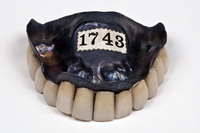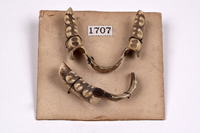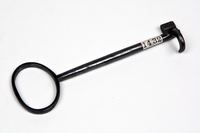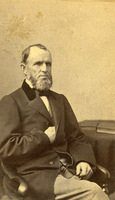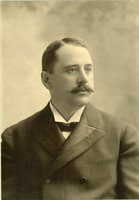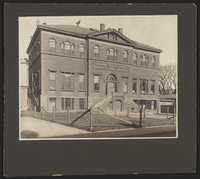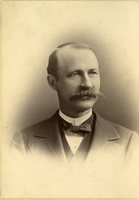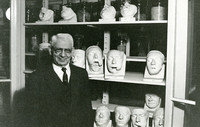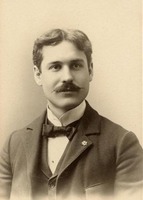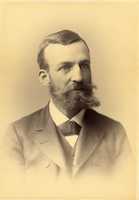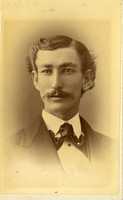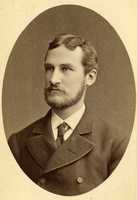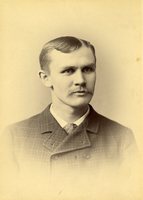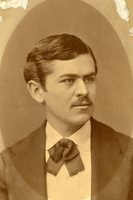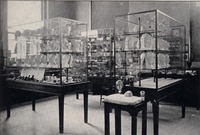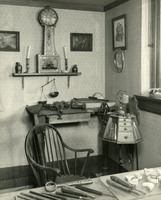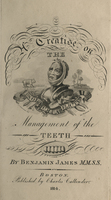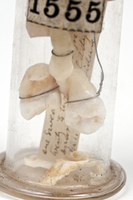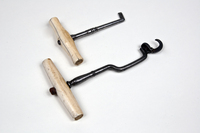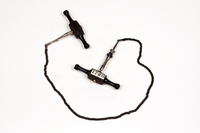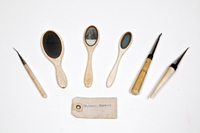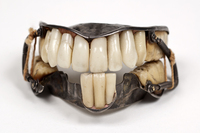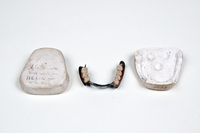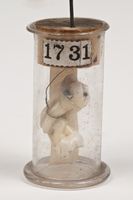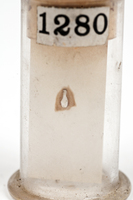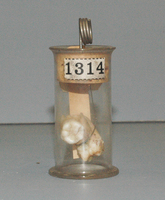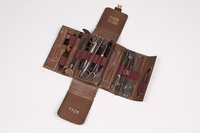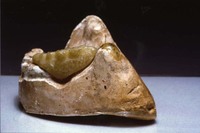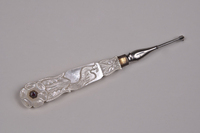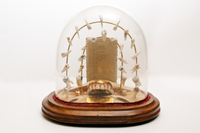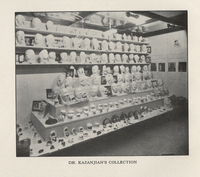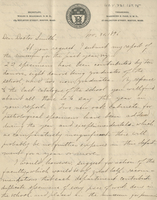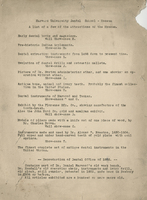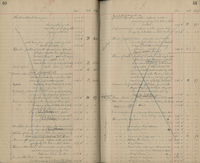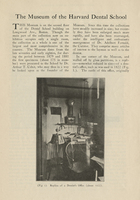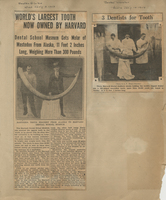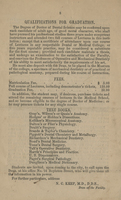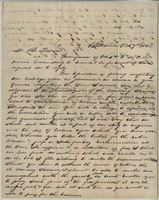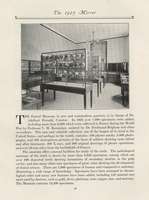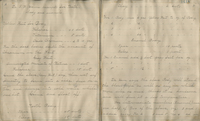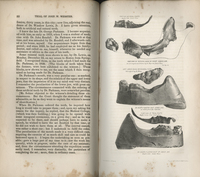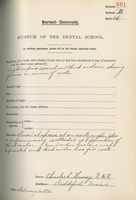Browse Items (46 total)
- Tags: Lost Museum
Sort by:
Turnkey from New Hampshire
This key instrument was carried to a town in New Hampshire when it was settled 100 years ago as part of the necessary articles to have for use in a new country . The donor received it from the descendents of the owner.
The Harvard Dental School and Dental and Oral Hospital
This photograph depicts the exterior of the Dental School building on North Grove Street during the period when the Museum was housed on its second floor. Ironically, the remains of George Parkman were discovered in the basement of this building in…
Thomas Fillebrown
Dr. Thomas Fillebrown (1836-1908) was a member of the first class to graduate from the Harvard Dental School and later held the professorship of Operative Dentistry and Oral Surgery. He was an ardent supporter of the Dental Museum and donated many…
Adelbert Fernald
The Museum's fourth curator, Dr. Adelbert Fernald (1871-1958), was in office from 1922 until his retirement in 1936 .
Waldo E. Boardman
Dr. Waldo E. Boardman (1851-1922) was the Museum's third curator, serving over thirty years, from 1891 until 1922. Boardman was also part of the class of 1886.
Charles Wilson
Dr. Charles Wilson (1842-1912) was the curator of the Museum from 1881 until 1891. Wilson was also part of the class of 1870.
Arthur T. Cabot
Dr. Arthur T. Cabot (1852-1912) was the first curator of the Dental Museum, serving from 1879 to 1881.
The Harvard Dental School Museum
The only surviving photographs of the interior of the Dental Museum are found in issues of The Mirror, the yearbook of the Dental School, and Richard Locke Hapgood's published History of the Harvard Dental School (1930). This photograph is from the…
Antique Dental Office
During his tenure as curator, Adelbert Fernald assembled a replica of an early 19th century dental office, based on that of Boston practitioner Dr. John Randall (1774-1843).
A Treatise on the Management of the Teeth
In addition to the collection housed in the library of the Dental School, there were also books, pamphlets, prints and pictures preserved in the Dental Museum, including this early text on Dentistry. The title-page engraving shows an inferior denture…
Superior denture/model with gold restorations
F. H. Veo was a dental graduate of the Class of 1897. This specimen is almost certainly the student piece he created as part of the requirements for graduation and then deposited in the Dental Museum.
Turnkey and Elevator
The turnkey (for extracting teeth) and the elevator (for extracting roots) were essential early dental instruments. These were used by Dr. George Brewster of Portsmouth, New Hampshire.
In "The Claims of Dentistry," an address at the 1872…
Flexible Chain Saw
Dr. Thomas Fillebrown (1836-1908) was a graduate of the first class of the Dental School in 1869 and later held the professorship of operative Dentistry and oral surgery. He donated many specimens and instruments to the Dental Museum.
Instruments of Daniel Harwood
These ivory-handled instruments (an excavator, scaler, chisel, and three mirrors) were used by Boston dentist Daniel Harwood (1801-1881). Soon after the formation of the Harvard Dental School in 1867, Harwood was appointed to the professorship of…
Diminutive Supernumerary
This supernumary tooth was removed from the jaw of an 11 year old boy; the rest of his teeth were very large.
Collection of Sturgeons' Teeth
In addition to its human specimens, the Dental Museum had a rich collection of skulls, jaws, and teeth from animals and fish to illustrate principles of comparative odontology.
Charriere Pocket Surgical Instrument Case
This complete portable surgical kit was used during the Civil War.
Casts of the Superior and Inferior Maxillae of George Parkman
These are the most historically significant specimens in the Dental Museum's collection
Scaler
This instrument was part of an ornamental set of scalers, mirrors, and a turnkey belonging to Thomas B. Hitchcock, former Dean of the Dental School.
Dissected Superior and Inferior Maxillary Bones
This specimen of dissection shows arrested development of the permanent teeth.
The specimen is of dissected superior and inferior maxillary nones showing arrested development of permanent tooth germs, natural absorption of roots of temporary…
Preparation of Dental Fillings
Another student piece illustrates the various techniques and compounds which could be used for filling teeth. There are twenty-nine dental preparations in a glass dome on a wooden base. The teeth are mounted on two gold arches.
Facial Moulages
During World War I, Dr. Varaztad H. Kazanjian (1879-1974) used his surgical skills to treat the soldiers severely disfigured during combat. In 1915, he was appointed chief dental officer of the First Harvard Unit, organized to serve overseas with the…
A List of a Few of the Attractions of the Museum
A brief overview of some of the highlights of the Dental Museum collection indicates the scope and breadth of the collection.
Catalog entry for Oliver Wendell Holmes denture
This version of the Museum's catalog was in use from the 1890s through 1907.
Here among the entries for items of mechanical dentistry are specimens 1562 and 1565
Here among the entries for items of mechanical dentistry are specimens 1562 and 1565
Catalogue of the Specimens in the Museum of the Harvard Dental School
This volume functioned as an accession book for specimens acquired by the Museum through 1896. Items were assigned an ordinal number and shelf location as received, and the information was later transcribed into the formal catalog. The items listed…
The Museum of the Harvard Dental School
George Howard Monks, the professor of oral surgery in the Dental School, presented an overview of the Dental Museum and its holdings to the Boston Medical History Club in March, 1925. The paper was then printed in the Harvard Alumni Bulletin and…
World's Largest Tooth Now Owned by Harvard
In 1929, Boston newspapers ran some unusual articles on the latest acquisition of the Dental Museum. This was no human Tooth, but a mastodon's tusk estimated to be 50,000 years old. Over 11 feet long and weighing 300 pounds, it was one of the…
Announcement of the Dental School of Harvard University, Session 1868-69
This first annual catalog from the Dental School lists the faculty members and outlines the course of instruction. Among the qualifications for graduation may be seen the earliest reference to the existence of the Dental Museum: "He must also deposit…
Letter from C. O. Cone to B. Palmer
The Dental Museum acquired and displayed manuscript and archival items, books, and photographs related to the history of the school and the profession of Dentistry. The letter from Dr. C. O. Cone, demonstrator of mechanical Dentistry at the…
The Mirror
From 1912 until 1943, the Dental School had its own yearbook, The Mirror, analogous to the Medical School's yearbook, The Aesculapiad. The 1925 edition describes the Dental Museum and its holdings and includes photographs of the interior and the…
Recipes of Bodies for Artificial Teeth
Dr. William Parker Cooke (HDS 1881) compiled these various recipes for the composition of artificial teeth from notable dental practitioners, including Thomas H. Chandler, Daniel Harwood, and Samuel F. Harris.
Report of the Case of John W. Webster
During the trial of John White Webster, Nathan Cooley Keep was called to identify the dental remains which were found in the basement of Harvard Medical School. Here Keep outlines the distinctive peculiarities of the teeth and lower jaw and…
Museum Catalog Entries
Each specimen in the Dental Museum was assigned a serial number and cabinet and shelf location. Sheets like these were used to record information about the item and its acquisition and were then bound together into formal catalogs.

